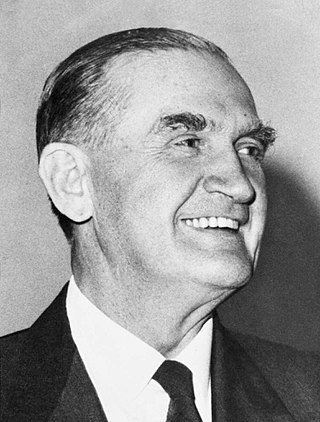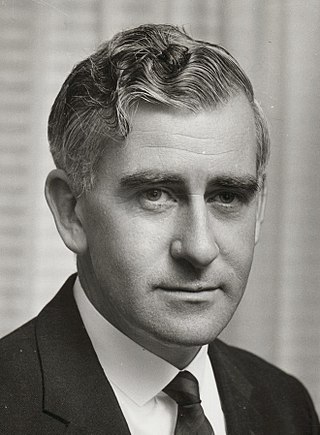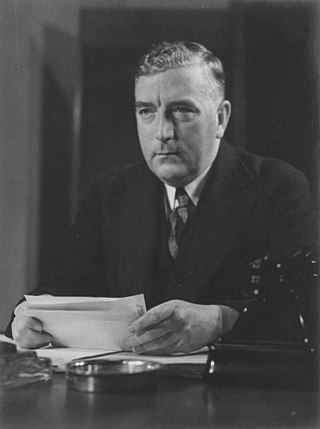
Harold Edward Holt was an Australian politician and lawyer who served as the 17th prime minister of Australia, from 1966 until his disappearance and presumed death in 1967, holding office as leader of the Liberal Party of Australia.
The National Party of Australia, also known as The Nationals or The Nats, is a centre-right Australian political party. Traditionally representing graziers, farmers, and regional voters generally, it began as the Australian Country Party in 1920 at a federal level.

Sir John Grey Gorton was an Australian politician who served as the 19th prime minister of Australia, from 1968 to 1971, holding office as the leader of the Liberal Party of Australia. Previously a senator for Victoria, he was the first and only member of the upper house to assume the office of prime minister.

Sir William McMahon was an Australian politician who served as the 20th Prime Minister of Australia, from 1971 to 1972, holding office as the leader of the Liberal Party of Australia. He was a government minister for over 21 years, the longest continuous service in Australian history.

Sir John McEwen was an Australian politician and farmer who served as the 18th prime minister of Australia, from 1967 to 1968, holding office as the leader of the Country Party. He was prime minister in a caretaker capacity following the disappearance of prime minister Harold Holt.

Sir Paul Meernaa Caedwalla Hasluck, was an Australian statesman who served as the 17th Governor-General of Australia, in office from 1969 to 1974. Prior to that, he was a Liberal Party politician, holding ministerial office continuously from 1951 to 1969.

Sir Billy Mackie Snedden, was an Australian politician who served as the leader of the Liberal Party from 1972 to 1975. He was also a cabinet minister from 1964 to 1972, and Speaker of the House of Representatives from 1976 to 1983.

John Douglas Anthony PC was an Australian politician. He served as leader of the National Party of Australia from 1971 to 1984 and was the second and longest-serving Deputy Prime Minister, holding the position under John Gorton (1971), William McMahon (1971–1972) and Malcolm Fraser (1975–1983).

The deputy prime minister of Australia is the deputy chief executive and the second highest ranking officer of the Australian Government. The office of deputy prime minister was officially created as a ministerial portfolio in 1968, although the title had been used informally for many years previously. The deputy prime minister is appointed by the governor-general on the advice of the prime minister. When Australia has a Labor government, the deputy leader of the parliamentary party holds the position of deputy prime minister. When Australia has a Coalition government, the Coalition Agreement mandates that all Coalition members support the leader of the Liberal Party becoming prime minister and mandates that the leader of the National Party be selected as deputy prime minister.

Leslie Harry Ernest Bury CMG was an Australian politician and economist. He was a member of the Liberal Party and served in the House of Representatives between 1956 and 1974, representing the Division of Wentworth. He held ministerial office in Coalition governments for nearly a decade, serving as Minister for Air (1961–1962), Housing (1963–1966), Labour and National Service (1966–1969), Treasurer (1969–1971) and Foreign Affairs (1971).

The Gorton government was the federal executive government of Australia led by Prime Minister John Gorton. It was made up of members of a Liberal-Country Party coalition in the Australian Parliament from January 1968 to March 1971.

The Holt government was the federal executive government of Australia led by Prime Minister Harold Holt. It was made up of members of a Liberal-Country Party coalition in the Australian Parliament from 26 January 1966 to 19 December 1967.

The Menzies government (1939–1941) refers to the federal executive government of Australia led by Prime Minister Robert Menzies. Menzies led the United Australia Party in the Australian Parliament from 1939 to 1941. Menzies served a later and longer term as prime minister as leader of a successor party, the Liberal Party of Australia from 1949 to 1966.

The McMahon government was the period of federal executive government of Australia led by Prime Minister William McMahon of the Liberal Party. It was made up of members of a coalition between the Liberal Party and the Country Party, led by Doug Anthony as Deputy Prime Minister. The McMahon government lasted from March 1971 to December 1972, being defeated at the 1972 federal election. Writing for the Australian Dictionary of Biography, Julian Leeser describes McMahon's prime ministership as "a blend of cautious innovation and fundamental orthodoxy".

On 17 December 1967, Harold Holt, the Prime Minister of Australia, disappeared while swimming in the sea near Portsea, Victoria. An enormous search operation was mounted in and around Cheviot Beach, but his body was never recovered. Holt was presumed to have died, and his memorial service five days later was attended by many world leaders. It is generally agreed that his disappearance was a simple case of an accidental drowning, but a number of conspiracy theories surfaced, most famously the suggestion that he was a spy from the People's Republic of China and had been collected by a Chinese submarine. Holt was the third Australian prime minister to die in office, after Joseph Lyons in 1939 and John Curtin in 1945. He was initially replaced in a caretaker capacity by John McEwen, and then by John Gorton following a Liberal Party leadership election. Holt's death has entered Australian folklore, and was commemorated by, among other things, the Harold Holt Memorial Swimming Centre.

A leadership election in the Liberal Party of Australia, the party of government in the Parliament of Australia, was held on 9 January 1968. It followed the disappearance and presumed drowning of previous leader Harold Holt, who had been declared dead on 19 December 1967. The contest was won by Senator John Gorton in a party room ballot; he was sworn in as prime minister the following day, replacing caretaker John McEwen.

The Liberal Party of Australia held a leadership spill on 7 November 1969, following the party's poor performance at the federal election on 25 October. Prime Minister John Gorton was re-elected as the party's leader, defeating challengers William McMahon and David Fairbairn.

The Liberal Party of Australia held a leadership spill on 10 March 1971. Prime Minister John Gorton called for a vote of confidence in his leadership, which was tied, prompting Gorton to resign. William McMahon subsequently defeated Billy Snedden for the leadership, and was sworn in as prime minister on the same day. Gorton was elected as his deputy, defeating Malcolm Fraser and David Fairbairn.
The leader of the National Party of Australia is elected by majority vote of the federal parliamentary party. A deputy leader is elected in the same fashion. The party's longest-serving leader is Earle Page, who held the office from 1921 to 1939. The party's current leader is David Littleproud, who has held this office since 2022. It is historically rare for the incumbent leader and deputy leader to be opposed in a bid for re-election.

The Leader of the Liberal Party, also known as Leader of the Parliamentary Liberal Party, is the highest office within the Liberal Party of Australia and the Liberal–National Coalition. The position is currently, and has been since 30 May 2022, held by Peter Dutton, who represents the Division of Dickson in Queensland. Peter Dutton is the fifteenth leader of the Liberal Party. Dutton is also the first leader of the party to represent a Queensland electorate.














